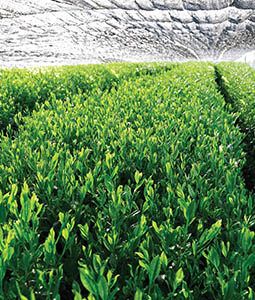Home > Highlighting JAPAN > Highlighting Japan May 2018 > Food and Agriculture Marketplace Potential
Highlighting JAPAN


Powdered Green Gold
The demand for Japan’s matcha powdered green tea, both in its drinkable form and as a healthy ingredient in processed foods, is growing worldwide.
Recognized and appreciated worldwide, fine matcha is gaining fans in the West and elsewhere in Asia. Ministry of Finance trade statistics reveal that exports of matcha rose 24.3 percent in 2017, and were worth nearly 14.36 billion yen (US$ 129 million)—the highest it’s been since 1988. Greater health consciousness worldwide has virtually every country drinking more green tea, with many becoming prime export markets. The USA is currently the major export destination for Japan’s matcha, followed by Taiwan, Germany and Singapore.
Shizuoka Prefecture and the city of Uji in Kyoto Prefecture are often considered Japan’s “tea capitals.” And yet the company that boasts the largest share of production both within Japan and globally is located in Nishio, Aichi Prefecture. AIYA was established in 1888, and was one of the “Global Niche Top Companies Selection 100” singled out by the Ministry of Economy, Trade and Industry.
Nishio’s temperate climate, rich fertile soil and abundant water resources by Yahagi River, and relatively sheltered environment are keys to its matcha dominance, and historically nearby castle towns such as Nagoya and Okazaki were major consumption areas.
Unlike many other tea production centers that produce all types of tea, Nishio is more focused. Over 96 percent of the area cultivated in Nishio is devoted to producing tencha, the raw tea leaves used for matcha. Tencha is relatively unknown because most of it is shipped out for processing. In 2017, the high-quality tea created from those leaves, Nishio Matcha, was registered under the Ministry of Agriculture, Forestry and Fisheries’ (see here). The GI mark inspires trust in product quality, and should lead to greater exports.
The development of tea ceremony culture means that Japan’s people have drunk matcha since ancient times. However, common folk tended to favor sencha green tea, which came into fashion because it was cheaper and easier to prepare, and didn’t involve the intimidating as the complexities and customs of the tea ceremony.
“The tea ceremony has survived because it is a meaningful practice, and I’m sure it will continue to exist,” says Takeo Sugita, AIYA’s president. “But many people avoided drinking matcha because they didn’t know the etiquette. If it had been drunk like coffee or Western tea, matcha might have developed into something more casual.”
Since the 1960s, AIYA has sought new markets, and also worked to overturn the stereotype that matcha is only for drinking. They began selling matcha as a raw ingredient to be used in processed foods, and in 1978 began growing it organically, long before that became fashionable. During the 1980s, matcha companies shifted away from marketing it as a raw ingredient. Instead, they used it to flavor various foodstuffs, such as sweets and ice cream, which established its place in Japan’s food culture.
The overseas market for matcha also expanded during the 2000s. Packed with antioxidants and rich in fiber, chlorophyll and vitamins, it gained acceptance as a health food in the United States. It’s also a luxury grocery item in cafés and homes in Europe. AIYA established local subsidiaries in the United States in 2001 and Austria in 2003. By 2017, international shipments had reached approximately the same level as domestic shipments.
Lately a movement has emerged in Japan determined to define the country’s matcha, as a way to differentiate it from powdered green tea produced in other countries.
“It’s meaningless if matcha is only used to gain prestige as a high-quality product made in Japan,” argues Sugita. “We may claim that a product is real Japanese matcha, but we can’t sell it overseas if it does not meet the needs of the country it is being exported to, which is the most important thing. Competition will only grow fiercer. We need to deeply understand the characteristics of each market, construct systems to generate tangible benefits and export everything from high-quality matcha to inexpensive products that can compete with the green teas produced relatively cheaply overseas. If we can’t, we won’t survive.”
Having a flexible approach to each country—such as whether to focus on quality or affordability, or whether to push tea for drinking or processing—leads to the expansion of overseas market shares. AIYA’s next strategies for expanding exports of its powdered green gold are the focus of a great deal of attention.
© 2009 Cabinet Office, Government of Japan







